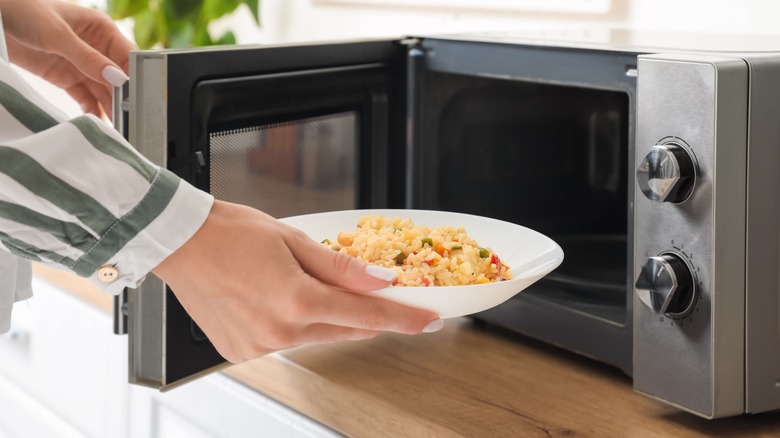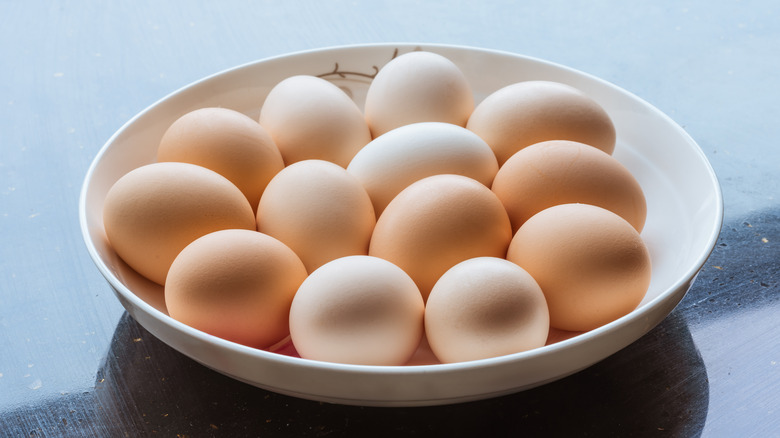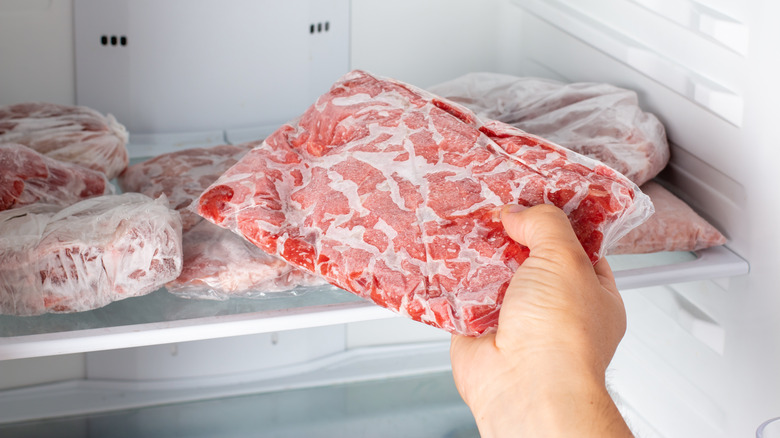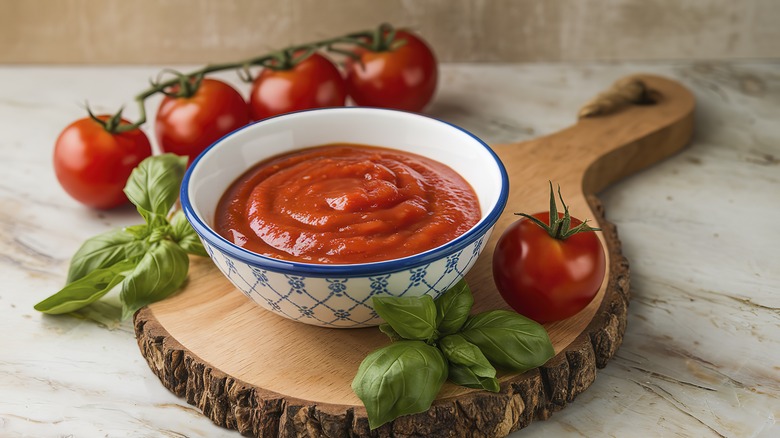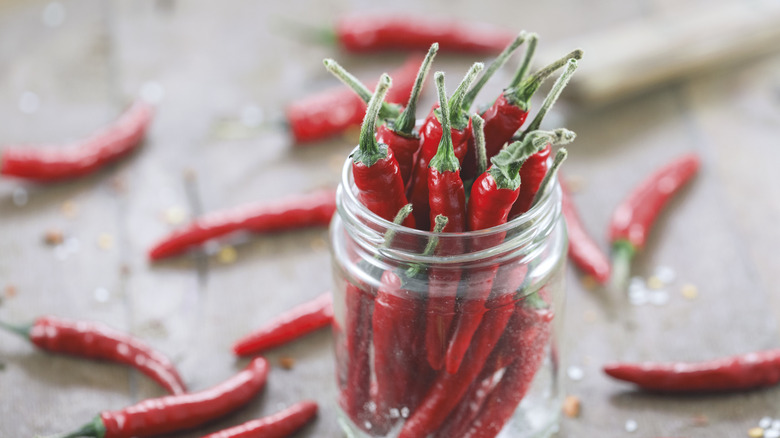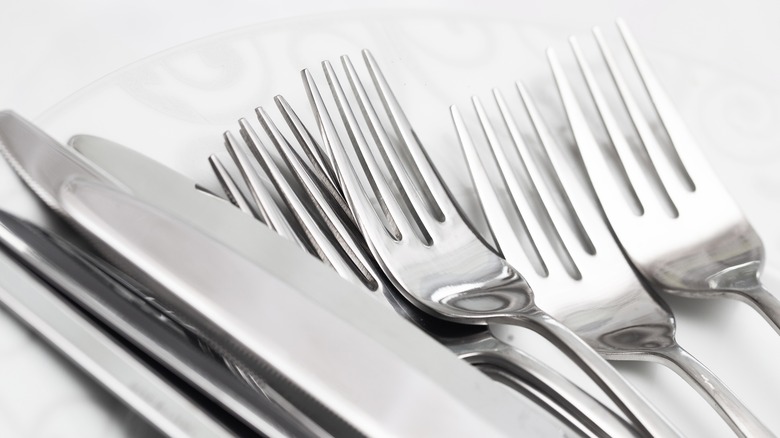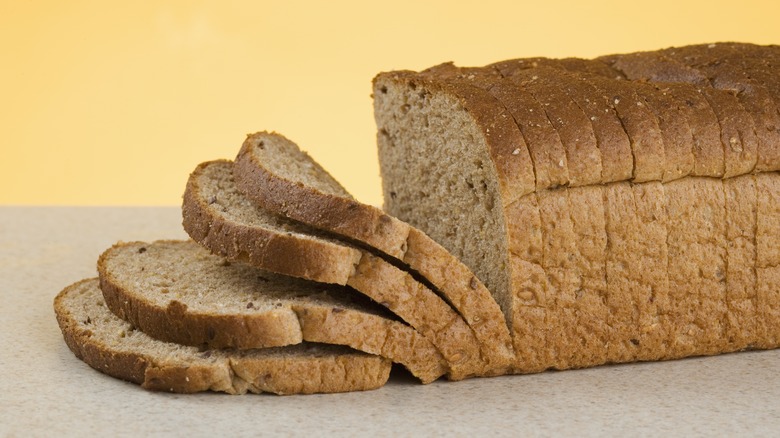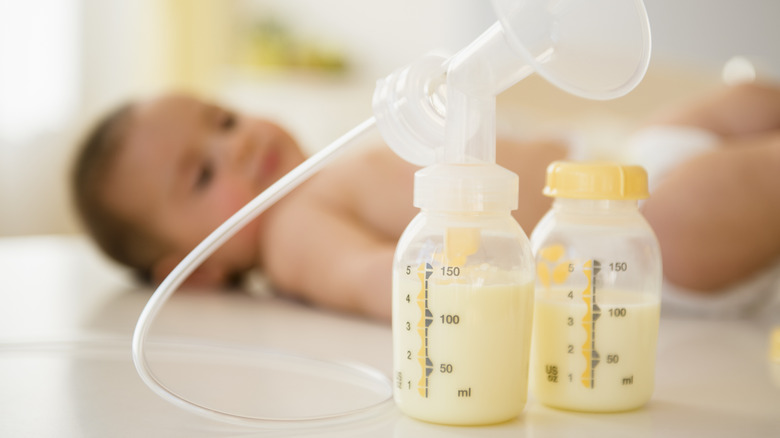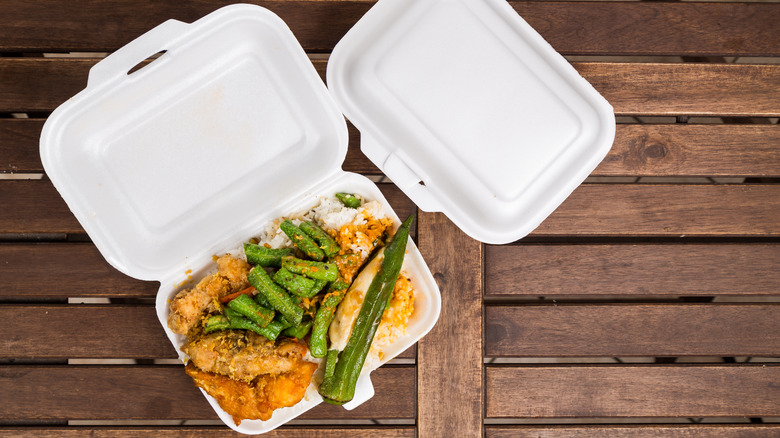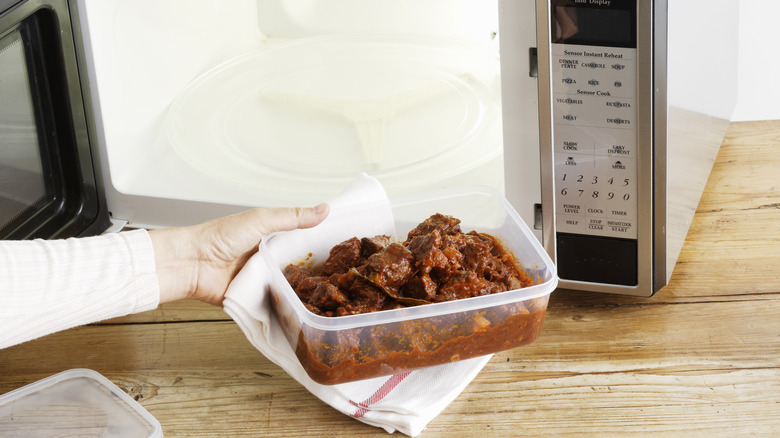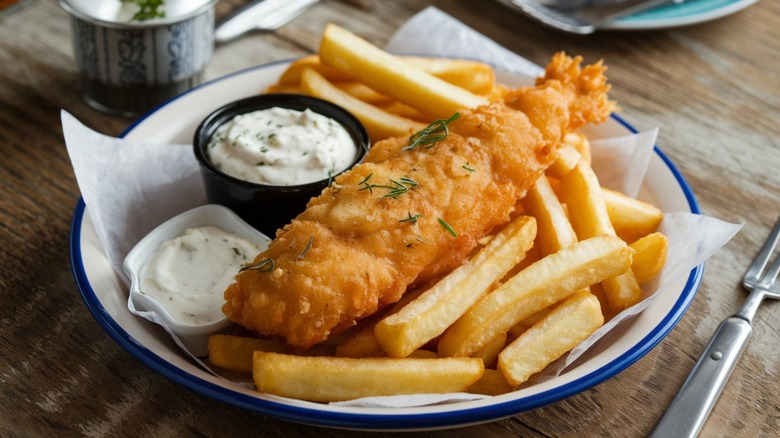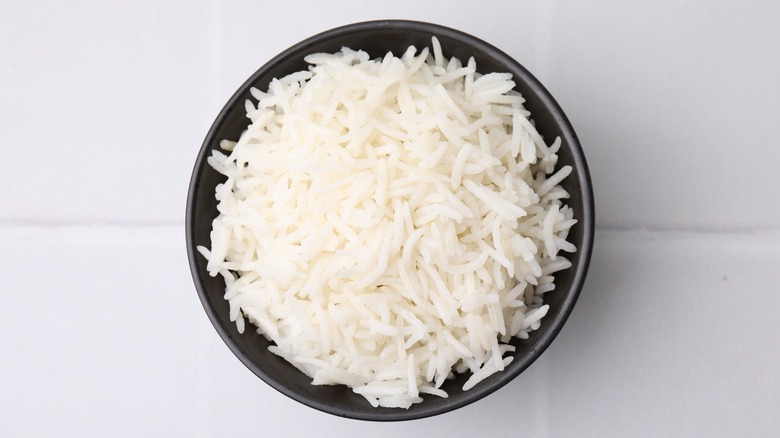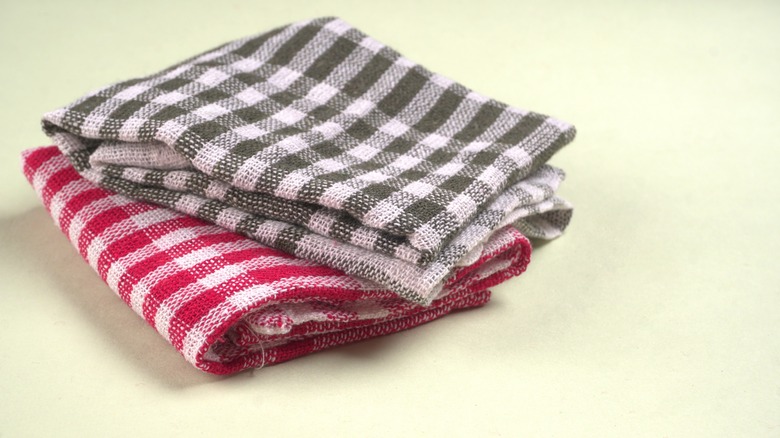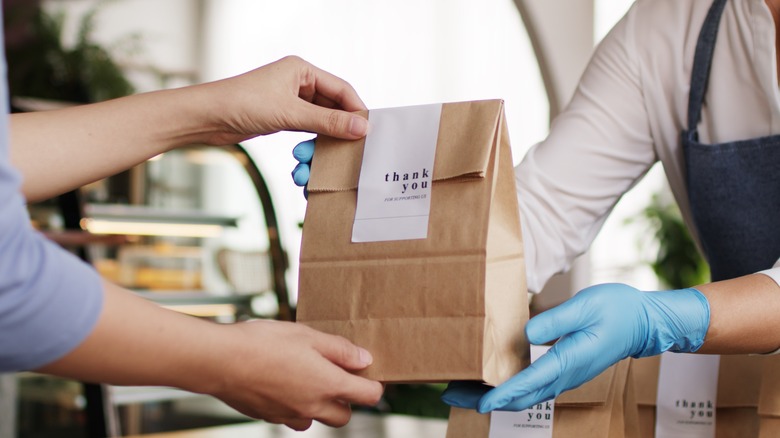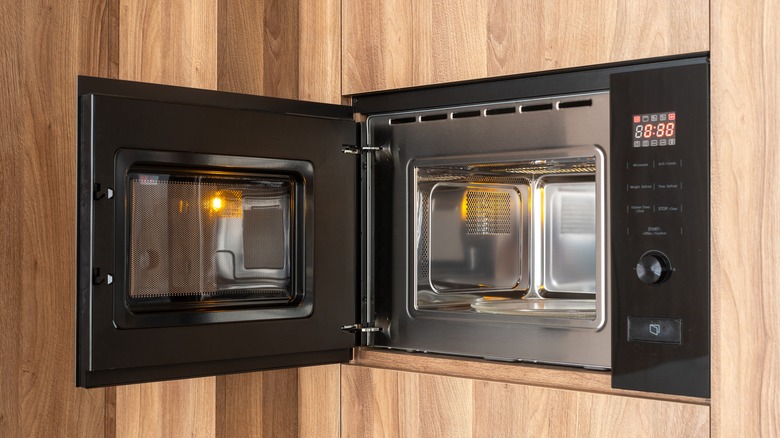15 Things You Should Never Put In A Microwave
Microwaves provide the ultimate convenience. From reheating last night's leftovers to making mug muffins, they save loads of time. But if you're getting brave with what you'll microwave, just know that not everything belongs in this electrical appliance — and placing the wrong item inside can lead to serious problems.
To understand why you can't microwave certain items, you should first understand how microwaves differ from other appliances. There's a reason microwaves heat up leftovers in minutes while your oven takes forever. Conventional ovens use radiant heat to warm food from the outside, while microwaves use electromagnetic waves that excite molecules inside food. This creates friction and heat, which warm your food up fast.
Unfortunately, this speedy method of cooking can also spell disaster with the wrong items. Some can't handle the electromagnetic intensity, while others develop pockets of heat so hot that they're just waiting to explode. We've all witnessed this to some degree, whether opening the microwave to discover food splattered everywhere or noticing alarming sparks that prompted immediate action. Luckily, these issues are preventable — and we're here to help. Below, we'll explore things you should never put in the microwave. Some are obvious while others will come as a complete surprise.
Eggs in their shell
When eggs are heated, steam builds up inside. If that egg is trapped within a shell, the steam has nowhere to go. So what happens? It explodes. This explosion may happen while it's heating up in the microwave, leaving you a smelly mess to clean — or, it can happen after opening the microwave door, resulting in a worse outcome (ie exploding in your mouth, which nobody wants to experience).
While you should never heat an egg in its shell, you should also be wary of microwaving eggs with whole yolks. Obviously, eggs are best served fresh. But if you must reheat them, make sure to puncture the yolks, even on hard-boiled eggs. This will let the steam safely escape, preventing any harmful egg-splosions.
Frozen meat
Before you get too heated, yes, you can put frozen meat in the microwave, but purely to thaw it. After thawing meat or poultry in the microwave, it should be immediately cooked elsewhere. This is because microwaves quickly warm frozen foods, but can also bring meats and poultry into the "danger zone," a temperature range between 40 F and 140 F in which bacteria multiply rapidly. Bacteria that existed on these meats pre-freezing come back to life, potentially growing to dangerous levels.
You might be thinking, can't I just microwave the frozen meat until it's fully cooked? Technically, yes, but we wouldn't recommend it. Microwaves tend to heat frozen food unevenly. One area could be cooked through, while another is entirely raw. Safety aside, cooking meat and poultry in the microwave results in an undesirable texture and flavor. Think dry, tough steak or chicken that feels like rubber. For delicious meat dishes, use a different appliance like a grill, stovetop, or air fryer. And if you're craving red meat, read our guide to cooking steak in the oven.
Uncovered sauces
Have you ever opened your microwave to discover what looks like a crime scene from a horror film? That's what you get when you reheat tomato-based sauces. When microwaved, liquids like marinara sauce and gravy build up steam. If you've watched them through the glass, you'd notice pockets of liquid bubbling until they erupt like a volcano.
Save yourself the cleanup by taking preventative measures. Always cover saucy dishes with a paper towel or a microwave-safe lid, and stir your food halfway through microwaving to prevent hot pockets from developing (and to achieve an even temperature throughout). For larger batches, consider heating them directly on the stove. It may take an extra minute or two, but it can avert disaster. And bear in mind that this microwave rule doesn't solely apply to liquids. Those stir-fries and pasta dishes come with enough sauce to also cause an explosion, so treat them similarly.
Spicy peppers
Spicy peppers are typically cooked into dishes or served as a cold garnish. But if you're feeling impatient, and you like your food piping hot, you might consider tossing those jalapeños in the microwave. But before you do, we should warn you of a hazard most people wouldn't expect. Spicy peppers contain capsaicin, the compound responsible for their fiery heat. When microwaved, this spicy substance vaporizes. Since that vapor is contained inside your appliance, opening the microwave may expose you to potent fumes.
The intensity of this vapor likely depends on the quantity and type of pepper you use, and ultimately, how much capsaicin is present. But regardless, we enjoy the fiery burn of peppers in our food — not our faces. As such, we wouldn't risk microwaving peppers. After all, capsaicin is what makes pepper spray so painful. It's odorless and colorless, so you won't see it coming — literally. But even small amounts can cause watery eyes and skin blisters.
Metal
We've all seen the lightning show that takes place when metal meets microwave. That forgotten spoon in the soup bowl can spark serious panic. But metal's sneaky presence extends beyond obvious cutlery. Think metal-lined takeout containers, grandma's china with metallic trim, or some unexpected aluminum. And while you may want to reheat coffee quickly, there are certain mugs you should never microwave, like that trusty metal travel mug.
Metal works just fine in a conventional oven, so why are microwaves different? Because metal reflects microwave radiation rather than absorbing it. When these waves bounce off metal surfaces, they create electrical currents that turn into sparks and a potential disaster. Not only can this concentrated heat destroy your food, but it can damage your microwave. As such, give your reheated platter a once-over, scanning for any metal before placing it in the microwave. If you want to reheat an item in a metal-lined tray, opt for a convection oven, instead.
Bread
Unlike many items on this list, microwaving bread isn't dangerous: It's just disgusting. We've all done it at one point or another, whether trying to create crispy bread without a toaster or quickly reheating a sandwich. But sadly, microwaving bread rarely yields desirable results.
Immediately after being heated, the bread is soft and super soggy. But what comes next is even more disappointing. After an extremely short window, the same slice of bread turns rock hard, as if it's been stale for a century. This is because microwaved bread is re-gelatinized, meaning the starch binds to water. Once the bread cools down and that water evaporates, the bread becomes tough and dry.
When heating bread, stick to the oven or the toaster. It might require a few more minutes but will be much more enjoyable. And the best way to reheat a sandwich is the oven or a panini press. Both result in warm, toasted bread and melty-hot fillings.
Breast milk
When a new baby arrives, there is a plethora of things to juggle. So when it comes time to heat breast milk, it's tempting to pop it in the microwave. But if you've read any parenting blogs or books, you'll know this is not a safe way to reheat breast milk. The bottle might feel perfectly warm to the touch, but as mentioned, microwaves heat from the inside out. This means the milk inside might be hotter than you imagine. Dangerous hot pockets may also exist, which could scald your baby's sensitive mouth and throat.
Temperature issues aside, microwaving breast milk damages its nutritional profile. The intense, rapid heat breaks down valuable proteins and nutrients that help your baby build up their immune system and grow strong. To safely reheat breast milk, stick to the tried-and-true method of a water bath. The extra time it takes will pay off for your baby's health and safety.
Grapes
We know what you're thinking: Why on earth would anyone put grapes in the microwave? Truthfully, few have — and that's a very good thing, because microwaved grapes won't turn into raisins: They'll turn into fireballs.
Proceedings of the National Academy of Sciences published a juicy scientific discovery regarding microwaved grapes. In the study, researchers learned that when you microwave grapes side by side, they ignite. This is due to grapes' high water content, which sits at roughly 82%. A microwave's wavelengths are about 12 centimeters in the air, but shortened to 1 to 2 centimeters in water, which is the same diameter as a grape. One of the researchers, Bianucci, shared with the outlet that "Microwaves can get trapped inside the grape." They can also 'hop' and, "This hopping results in a very strong electromagnetic field in between the grapes." When this electromagnetic field grows strong enough, it becomes plasma — the same stuff the sun is made of.
The study showed that this phenomenon isn't limited to grapes. It can happen with other water-heavy, grape-sized items. The study used hollowed-out quail eggs filled with water — which again, we'd never think to create, let alone microwave. However, if you're reheating a dish garnished with two fresh cherry tomatoes, we'd be wary of the potential outcome.
Styrofoam
Styrofoam takeout containers and cups are less prevalent these days — and for good reason. Not only are these single-use materials wasteful, but styrofoam can cause negative health effects when microwaved. Styrofoam is technically a brand name for expanded polystyrene foam (EPS), which breaks down when exposed to high heat. This process releases harmful compounds directly into your food. This includes the chemical styrene, which an Epidemiology study linked to leukemia in humans.
Several states and cities have banned single-use plastics altogether. If you're in Colorado, Maine, Maryland, Washington D.C., or anywhere else with similar legislation, you should be in the clear. But if you're in a region that allows said plastics and find yourself with styrofoam-packaged leftovers, transfer them to a more secure vessel. Although some EPS boxes come with "microwave-safe" labels, we still wouldn't risk it. Your best bet for a microwave-safe container is glass or ceramic specifically labeled as such.
Plastics
Styrofoam isn't the only plastic to watch out for. It seems plastic containers are everywhere these days, from takeout vessels to packaged food products. To be environmentally friendly, you may have even re-purposed some of those used yogurt tubs into leftover containers. But before popping them in the microwave, know they're not always designed for high heat.
Heated plastic can release compounds like BPA and phthalates into your food. These aren't harmless chemicals — they're well-known endocrine disruptors. This is a fancy way of saying they'll mess with your body's delicate hormonal balance, which affects everything from fertility and reproduction to metabolism and mood. Even those BPA-free plastics can still contain phthalates or other dangerous components. And 'microwave-safe' plastics also feel like a lie, especially with all the new research regarding microplastics entering the human body. Your safest option is avoiding plastics altogether.
Breaded or fried foods
Don't waste breaded or fried foods in the microwave. Their texture won't be nearly as satisfying after being zapped with radiation heat. You can forget that rich, crunchy mouthfeel of fried foods. Instead, these items will end up a sad, soggy shadow of their former selves. The reason? Since microwaves heat food from the inside out, moisture gets trapped inside. This waterlogs a dish, detracting from that fatty, fried texture we love.
Breaded and fried foods are best served hot. But just because you shouldn't use the microwave, doesn't mean you can't have your (fried) cake and eat it, too. Try re-frying the food on the stovetop in a small amount of oil. Alternatively, a standard or toaster oven heats food from the outside, evaporating surface moisture to maintain that crispy exterior. When baking or frying foods like fried chicken, make sure to go low and slow. Otherwise, you'll end up with a hot breaded exterior and cold meat.
Leftover rice and pasta
We rarely cook just enough rice or pasta to go with a meal. Instead, we make far more than necessary, saving the surplus for later. Unfortunately, reheating these starchy dishes comes with some risky side effects. Rice and pasta contain a spore-forming bacteria called bacillus cereus, which can survive high-heat cooking and lead to food poisoning. When rice or pasta is hot or in the fridge, the bacteria may go dormant, but when returned to room temperature, the bacteria multiply. And each time the dish cools increases the likelihood of bacterial infection. So while many people reheat rice or pasta and feel just fine, we wouldn't make a repeat habit of it, especially with the same bowl.
When left at room temperature, the bacteria can multiply and lead to food poisoning in as little as two hours. Symptoms of bacillus cereus food poisoning typically come on 30 minutes to 15 hours after eating contaminated foods, and include nausea, vomiting, or diarrhea. Although people generally recover within 24 hours, food poisoning is believed to alter the gut microbiome for far longer.
Fabric
Can you dry clothes in the microwave? Not unless you want them to catch fire. That damp sock or rain-soaked shirt might seem like a good candidate for a quick microwaving. However, microwaving fabric could result in a dangerous and potentially life-threatening risk.
When thoroughly wet, the fabric heats up and releases steam, but as it begins to dry or if it contains dry sections, it becomes dangerously hot. Heat gets trapped within the fibers, creating a hazard that continues even after removal from the microwave. A smoldering piece of fabric placed on a flammable surface — like a wooden deck — can easily trigger a much larger fire.
For hot compresses, use a towel soaked in boiling water, instead. And for drying clothes? Stick with a reliable dryer or drying rack — methods that will not turn laundry day into an emergency evacuation.
Paper bags
When food delivery arrives in a paper bag, it seems only natural to microwave the entire thing. Unfortunately, your average paper bag isn't microwave-safe. It is not heat resistant, and those thin fibers can quickly catch fire. Depending on what your bags are made of, they can also release harmful chemicals when heated.
Paper easily burns, and if you throw a newspaper on a fire, you will watch it shrivel up in seconds. However, some paper products can handle microwaving, including specific types of waxed paper or white paper towels. As such, we understand if there's some confusion — but if you're uncertain, and you don't see that 'microwave-safe' label, avoid putting paper products in the microwave altogether. Science experiments can be fun in a safe, controlled setting, but ruining a microwave and creating a fire risk isn't worth it. You have to remove the bag to eat anyway, so why not do this before reheating your food?
Nothing at all
Have you ever hit the start button on a microwave only to realize there's nothing inside? It happens to the best of us. Even if initially unaware, you'll quickly notice sparks flying. Under normal circumstances, microwave energy is absorbed by food. But without this target, those electromagnetic waves go wild. This is precisely why GE Appliances cautions consumers that operating a microwave oven while empty can damage the appliance or even cause a fire.
We've also experienced firsthand that putting too little food in the microwave can create the same effect. If you want to microwave a teaspoon of butter or a single bite of your sandwich, consider adding it to a larger plate of food. But if you catch yourself accidentally running the microwave while empty, don't freak out. A microwave that continues to function is safe to use. But if you'd like to keep your appliance in tip-top shape, stop making microwave mistakes – including heating the wrong food (or no food at all).
